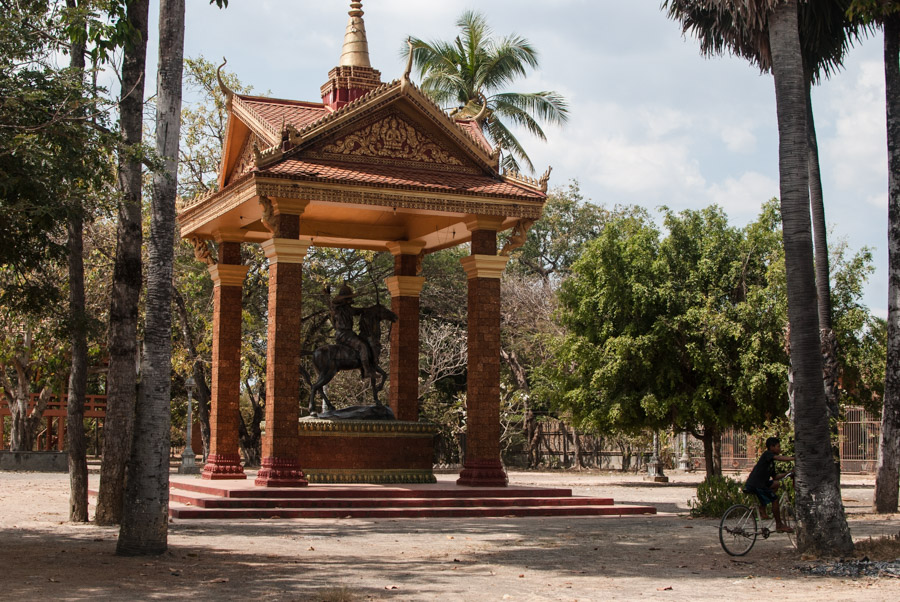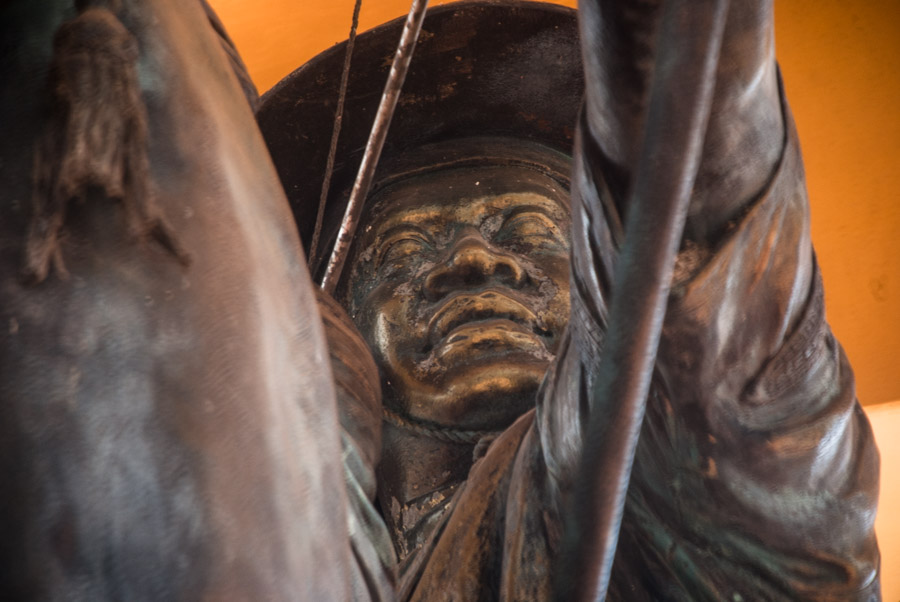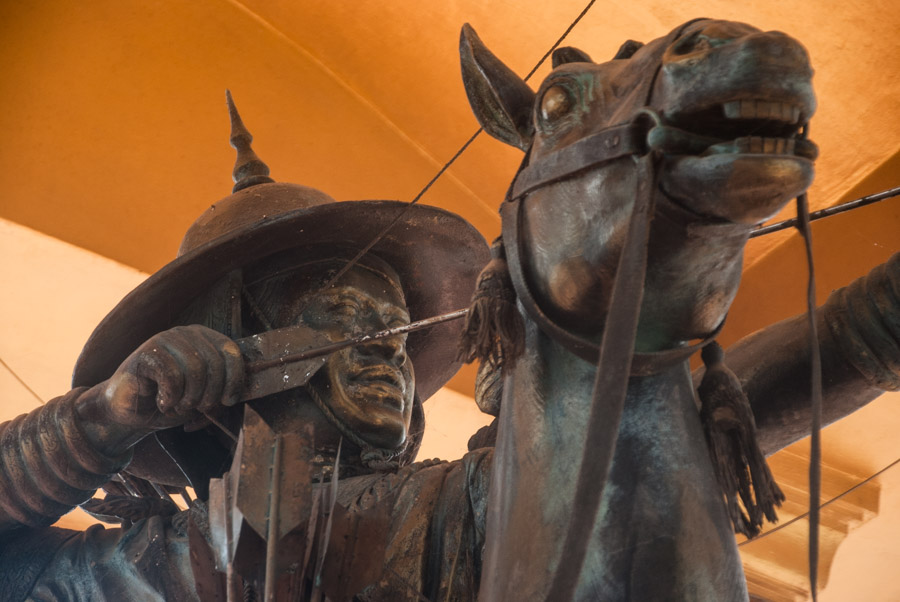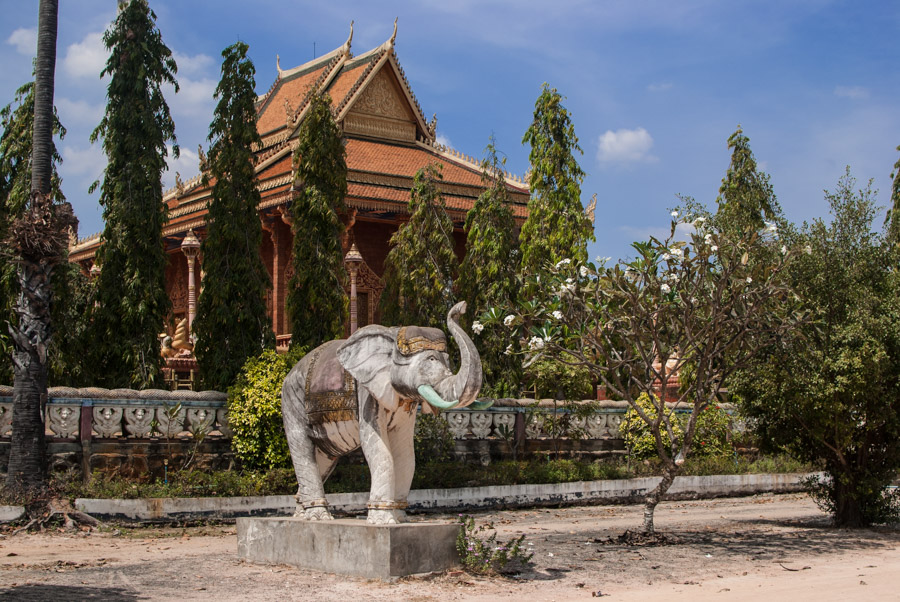The former capital of the 16th century Cambodian King Sdech Kan is a sleepy place, filled with birdsong and that particular air of shabby mysticism that seems to surround pagodas in rural parts of Cambodia. Nothing much is left of the old city, known as Srolop Prey Nokor, except checkerboards of parched rice paddies and the remains of the broad moat and earthworks that once surrounded the capital. Inside, the only real attraction is a small pagoda where a statue of Sdech Kan rises in front of a newly built temple compound enclosing two crumbling pre-Angkorian ruins.
The statue shows the king as an archer mounted on a fierce-looking stallion — a typical warrior pose. The most significant thing is that the king’s face bears a deliberate resemblance to a successor whose “reign” recently entered its 32nd year: Prime Minister Hun Sen.
Sdech Kan, who only ruled Cambodia for a short period after the decline of the Angkorian empire, was until recently a mostly forgotten figure. According to legend, he came from a humble background and served in the court of King Srey Sukonthor Bat. In 1512, he overthrew the king, after the latter sought to have him killed based on a premonition that the young man would topple him from power. Kan went on to establish a reign of peace and prosperity, but was ousted in 1525 by the deposed monarch’s brother.
Despite the lack of documentary evidence of Kan’s reign, Hun Sen has come to closely identify with him. He has sponsored research into Kan’s capital, and funded a 2006 book on Kan for which he also wrote the preface. Statues of Sdech Kan, bearing Hun Sen’s face, have appeared around the country, commissioned by tycoons and senior officials. The Sdech Kan story is now being made into a film. With a $1 million budget, Preah Sdech Kan, currently in production, will be the most expensive film in Cambodian history.
Identifying with greatness
Why the obsession with such an obscure historical figure? In a 2013 article, Swedish academic Astrid Noren-Nilsson wrote that Hun Sen has used the story to bolster the legitimacy of his long and controversial rule. On one level Sdech Kan’s overthrow of a king provides a precedent for Hun Sen’s political marginalization of the Cambodian monarchy and its replacement with his own peaceful “reign.” For Hun Sen, who has described Kan as a “brilliant hero,” the story is also one of social mobility and the triumph of men of moral virtue — both of which offer insights into how the prime minister wishes to be seen.
Despite presiding over the longest stretch of peace in modern times, Hun Sen has always struggled for legitimacy. He was born into a peasant family in 1952, instead of coming from Cambodia’s traditional royal and political elites. To make matters worse, his government was installed in power in 1979 by the hated Vietnamese, an association that still clings to him and has hardly been dispelled by his intolerant, authoritarian style of rule. The longer he is in power, the deeper is Hun Sen’s apparent need to justify his rule — and he has done this in part by trying to connect his “peasant king” reign to that of a previous non-royal ruler.
The Sdech Kan myth has been hotly contested by Hun Sen’s rivals. Opposition leader Sam Rainsy has described Kan not as a hero, but as a usurper, and in a recent post on his Facebook page, extolled a military commander who helped overthrow Kan and restore the “legitimate heir” to the throne — a subtle thrust at Hun Sen’s pretensions.
This debate offers an interesting illustration of the obscure symbolic undercurrents that run beneath the surface of Cambodian politics. It also demonstrates the limits of such historical allegories. In 2013, the ruling Cambodian People’s Party nearly lost an election because the government failed to address problems like corruption, land grabs, and deforestation. There is also little evidence that Sdech Kan has captivated Cambodians. On a recent visit to his former capital in Tboung Khmum province, I found it empty except for some young monks and a couple of women grinding out sugar cane juice beneath the shade of the chhuteal trees. Few knew much about Sdech Kan, except that he was once king.
Cambodia’s next election in 2018 will no doubt be a characteristically solipsistic affair, dominated by personality over policy. But politicians will need to do more than spin myths for a discontented populace. They may remain fixated on the past, but increasing numbers of Cambodian voters will be looking to the future.
Published by Nikkei Asian Review, February 18, 2016







